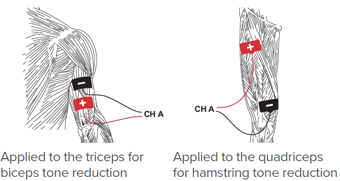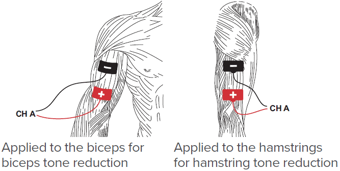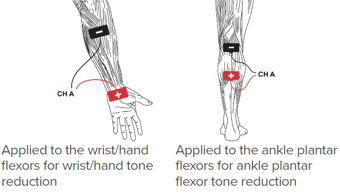Hypertonia is a common impairment associated with a wide range of neurological conditions and can significantly impair function and lead to joint pathologies. The use of biophysical agents including patterned electrical neuromuscular stimulation (PENS), TENS-LVPC motor stimulation to acupoints, and subthermal ultrasound over GTOs may assist in tone reduction (ACP, 2019). Research supports the use of electrical stimulation as an adjunctive tool in the treatment of hypertonicity which may facilitate improved range of motion and mobility.
- NMES combined with other treatment techniques provides reduction in spasticity and increases range of motion in patients with stroke leading to improvement in functional activity. (Stein, 2015)
- NMES combined with other interventions has beneficial effects on improving lower extremity motor function including gait speed, balance, spasticity, and ROM in chronic stroke survivors. (Hong, 2018)
Three Additional Electrical Stimulation Tone Reduction Strategies
For assistance with protocol selection or treatment set-up, please contact your ACP Clinical Program Consultant or the Remote Clinical Services line (800-350-1100, option 2)
MFAC Reciprocal Inhibition:
- Mechanism of Action: Electrical stimulation-induced contractions applied to the opposing (antagonist) muscle of the muscle in spasm activates reciprocal inhibition (via excitation of spinal inhibitory interneurons to the spastic muscle), thereby reducing tone. This may result in improved agonist function.
- Application Site: Antagonist muscle group (muscle that
opposes the muscle exhibiting tone/spasm).
MFAC Nerve Block:
- Mechanism of Action: Medium frequency (5000 Hz) stimulation reduces muscle tone or spasm by blocking the transmission of afferent pain signals to the spinal cord and efferent output to the muscle, thereby interrupting the
pain/spasm cycle. - Application Site: Muscle/muscle group exhibiting tone/spasm.
MFAC Tone-Spasm:
- Mechanism of Action: Repeated electrical stimulation-induced muscle
contractions cause muscle fatigue, thereby reducing muscle spasms. - Application Site: Muscle/muscle group exhibiting tone/spasm.
References:
ACP. (November, 2019). Tip of the Month: Management of Tone with Biophysical Agents, MRK 0286(1)
Hong, Z., Suie, M., Zhuang, Z., Liu, H., Zheng, X., Cai, C., Jin, D. (2018). Effectiveness of Neuromuscular Stimulation on Lower Limbs in Patients With Hemiplegia After Chronic Stroke: A Systematic
Review. Archives of Physical Medicine and Rehabilitation, 99, 1011-1022
Stein, C., Fritsch, C. G., Robinson, C., Sbruzzi, G., Plentz, R. D. (2015). Effect of Electrical Stimulation in Spastic Muscles After Stroke: Systematic Review and Meta-Analysis of Randomized
Controlled Trials. Stroke, 46(8), 2197-2205
